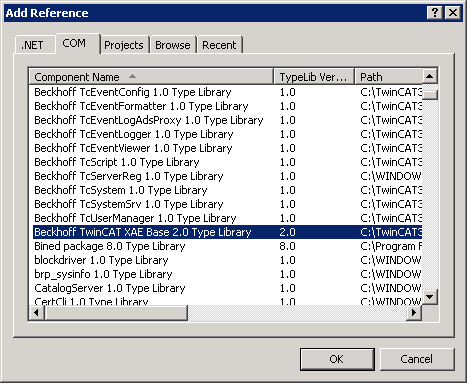Installation
All files needed for the TwinCAT Automation Interface will be installed automatically during TwinCAT setup. As mentioned in the introduction, the Automation Interface communicates with TwinCAT via COM. All needed COM objects are configured automatically so that COM-capable programming and scripting languages can access these objects.
Using the Automation Interface within a .NET application (C#, VB.NET, ...)
To access the Automation interface from a .NET application, you need to add a reference to the corresponding COM object Beckhoff TwinCAT XAE Base (depending on your TwinCAT version, see table below) within the Visual Studio project.

After the reference has been added, you can access the COM object via the namespace TCatSysManagerLib .
Please proceed with the article Accessing TwinCAT configuration which explains all further steps in more detail.
Using the Automation Interface within scripting languages
TwinCAT Automation Interface can also be used with COM-capable scripting languages, for example Windows PowerShell or IronPython. As scripting languages are being interpreted at runtime and not compiled, they always have access to all currently registered COM objects in the operating system. Therefore a reference is not needed.
Please proceed with the article Accessing TwinCAT configuration which explains all further steps in more detail.
Type library versions
During the TwinCAT product lifecycle, the type library mentioned above may be delivered in different versions because of added functionalities and/or big TwinCAT versions steps. The table below gives an overview about all different type library versions.
Type library name | Type library version | TwinCAT version |
|---|---|---|
Beckhoff TCatSysManager 1.1 Type Library | 1.1 | TwinCAT 2.11 |
Beckhoff TwinCAT XAE Base 2.0 Type Library | 2.0 | TwinCAT 3.0 |
Beckhoff TwinCAT XAE Base 2.1 Type Library | 2.1 | TwinCAT 3.1 |
Beckhoff TwinCAT XAE Base 3.1 Type Library | 3.1 | TwinCAT 3.1 Build 4020.0 and above |